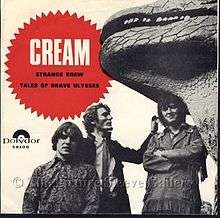Tales of Brave Ulysses
"Tales of Brave Ulysses" is a song recorded in 1967 by British group Cream.[2] It was released as the B-side to the "Strange Brew" single in June 1967.[3] In November, the song was included on Cream's second album, Disraeli Gears.[4] The song features one of the earliest uses of a wah-wah pedal, which guitarist Eric Clapton plays throughout the song.
| "Tales of Brave Ulysses" | ||||
|---|---|---|---|---|
 Norway picture sleeve | ||||
| Single by Cream | ||||
| from the album Disraeli Gears | ||||
| A-side | "Strange Brew" | |||
| Released |
| |||
| Recorded | May 1967 | |||
| Studio | Atlantic, New York City | |||
| Genre | Psychedelic rock[1] | |||
| Length | 2:50 | |||
| Label | ||||
| Composer(s) | Eric Clapton | |||
| Lyricist(s) | Martin Sharp | |||
| Producer(s) | Felix Pappalardi | |||
| Cream UK singles chronology | ||||
| ||||
| Cream US singles chronology | ||||
| ||||
| Audio sample | ||||
| ||||
Background
The song was the first collaboration between guitarist Eric Clapton and artist Martin Sharp. Clapton composed the music, inspired by the Lovin' Spoonful's 1966 hit "Summer in the City". "I just started chatting to Eric", said Sharp, who lived in the same building. "I told him I had written a poem. He, in turn, told me he'd written some music. So I gave him my poem. Two weeks later, he turned up with it on the B-side of a 45 record."[5]
The song was the B-side for "Strange Brew" in June 1967, several months ahead of the group's second album, Disraeli Gears, which included both songs. AllMusic's Matthew Greenwald calls it, "One of a few overtly psychedelic songs to have aged gracefully ... Lyrically, it's a relatively factual and colorful rendering of the great Greek tragedy Ulysses".[1]
In his 2007 autobiography, Clapton recalls:
When [first meeting Sharp] he heard that I was a musician, he told me he had written a poem that he thought would make good lyrics for a song. As it happens, I had in my mind at that moment an idea inspired by a favorite [sic] song of mine by the Lovin' Spoonful called "Summer in the City," so I asked him to show me the words. He wrote them down on a napkin and gave them to me ... These became the lyrics of the song "Tales of Brave Ulysses".[6]
The song uses a "C/B flat/F chord pattern", which Greenwald describes as "simple but effective".[1] Jack Bruce, on bass, also provides the vocal, and Ginger Baker is on drums.
Cream recorded the song at Atlantic Studios in New York City in May 1967, during the sessions for Disraeli Gears.[6] Atlantic brought in engineer Tom Dowd and producer Felix Pappalardi to work with Cream on their next album. For the recording, Clapton used a wah-wah pedal guitar effects unit for the first time.
Cream performed the song in concert and a 10 March 1968 recording from Winterland in San Francisco is included on Live Cream Volume II.[1] In May 1968, the group were filmed performing it for The Smothers Brothers Comedy Hour television programme.[7] "Tales of Brave Ulysses" was later overshadowed by "White Room", which utilised the chord progression and wah-wah to create one of Cream's biggest hits.[1]
References
- Greenwald, Matthew. "Cream: Tales of Brave Ulysses – Song Review". AllMusic. Retrieved 9 September 2016.CS1 maint: ref=harv (link)
- Welch, Chris (2011). Clapton. Voyageur Press. eBook. ISBN 978-1610597715.CS1 maint: ref=harv (link)
- "Cream, Blind Faith, Dominos". The Eric Clapton Lyric Archive. eric-clapton.co.uk. 3rd Cream Single. Retrieved 27 September 2011.
- Gilliland, John (1969). "Show 53 - String Man. : UNT Digital Library" (audio). Pop Chronicles. University of North Texas Libraries.
- "Sleevenotes – the inside story of a classic album cover", Classic Rock #56, August 2003, p8
- Clapton, Eric (2007). Clapton: The Autobiography. New York City: Broadway Books. pp. 85–86. ISBN 978-0-7679-2536-5.CS1 maint: ref=harv (link)
- Schumacher, Michael (1993). Crossroads: The Life and Music of Eric Clapton. New York City: Crown Trade Paperbacks. p. 107. ISBN 0-517-88118-7.CS1 maint: ref=harv (link)
Sources
- Hjort, Christopher (2007). Strange Brew: Eric Clapton & the British Blues Boom, 1965–1970. London, UK: Jawbone Press. pp. g. 29. ISBN 978-1-906002-00-8.
- Ertegün, Ahmet (2006). Classic Albums: Cream – Disraeli Gears (DVD). Eagle Rock Entertainment.
External links
- Lyrics of this song at MetroLyrics
- Grimm, Beca (3 February 2011). "You've Never Heard Cream's 'Disraeli Gears'?!". All Things Considered. Retrieved 9 September 2016.CS1 maint: ref=harv (link)